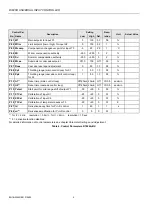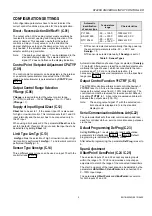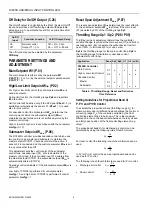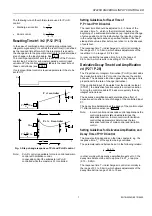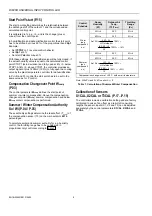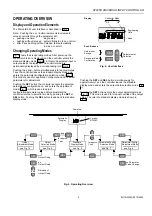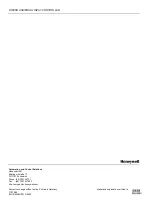
R7426D UNIVERSAL INPUT CONTROLLER
5
EN1B-0204GE51 R0403
CONFIGURATION SETTINGS
All configuration parameters have to be set to select the
correct control functions as required for the job application.
Direct - Reverse Action Dir/RevY1 (C.01)
The output action of the analog output must sometimes be
reversed for a correct opening and closing direction of the
valve or damper. This depends on whether the output
controls a 2-way or 3-way valve or on the direction the
damper shaft moves to open the damper (cw or ccw). It is
only needed, if the actuator does not provide a direction
selector switch, plug or similar.
Note:
The analog output signal Y1 can be displayed in the
standard display mode. The selected action of
signal Y1 does not influence the display indication.
Control Point / Setpoint Adjustment CPATYP
(C.05)
The control point or setpoint can be adjusted via the internal
or an external potentiometer connected to the CPA/SPA
input. The potentiometer type is selected by
CPATYP
(see
Output Control Range Selection
YRange (C.06)
YRange
is required to select the output control range
(0...100%) to either 2...10Vdc (
YRange
= 0) or 0...10Vdc
(
YRange
= 1).
Supply of Input Signal X2ext (C.12)
X2ext
has to be set to 1, if the sensor input X1 is also used
for high or low limit control. This interconnects the X1 and X2
input internally and the sensor has to be connected only to
the X1 input.
When using a limit sensor X2, the parameter
X2ext
has to be
set to 0 (default). If sensor X2 is not used, the input has to be
deactivated by setting
X2ext
to 2.
Limit Type LimTyp (C.13)
LimTyp
allows the selection of high or low limit control. High
limit control is performed if
LimTyp
= 1 and low limit control is
performed if
LimTyp
= 0.
Sensor Type Senstyp (C.14)
Three different sensor types can be used on input T3 with the
Automatic
identification
of sensor type
Temperature
range
Characteristics
Pt 1000
-30....+130
°
C
1000
Ω
at 0
°
C
BALCO 500
-30....+130
°
C
500
Ω
at 23.3
°
C
NTC 20k
Ω
-30....+85
°
C /
-30....+130
°
C
1)
20k
Ω
at 25
°
C
1)
NTC sensor is detected automatically, if during power up
the sensor temperature is within -30....+85
°
C and
Senstyp
= 0.
NTC sensor is selected manually, if
Senstyp
is set to 1.
Table 5. Sensor Types
Automatic identification of sensor type is selected, if
Senstyp
= 0 (default). After power up reset the controller detects auto-
matically the type of sensor, which is connected to the tem-
perature input T3. For a correct auto detection, it is
necessary that the measured temperature is in the specified
range (see Table 5).
Output Control Function Y1CTRF (C.15)
The R7426D controller performs direct control behaviour, if
Y1CTRF
is set to 0. A rise in the measured variable will
increase the output value from 0...100% (direct acting). The
control action must be reversed for reverse control behavior
by setting
Y1CTRF
to 1. A rise in the measured variable will
decrease the output value (100..0%).
Note:
The analog output signal Y1 with the selected con-
trol behavior is displayed in % in the standard
display mode.
Serial Communication Address Adr(C.22)
The parameter
Adr
sets the serial communication address,
used for controller start-up, service or maintenance purposes
via the bus.
Default Programming DefProg (C.23)
Setting
DefProg
to 1 resets all control and configuration
parameters to defaults (see Table 3 and Table 4). Default
programming is indicated by a display of
def
.
After default programming, the parameter
DefProg
is reset to
0.
Span Adjustment
UStartPoint / UendPoint (C.24 / C.25)
The universal inputs X1 and X2 accept any analog inputs
within the range of 0...10Vdc and provides an input span
adjustment to match the range of the connected transmitters.
The start / end point of the input span can be adjusted by the
parameters
UStartPoint
/
UendPoint
and is converted to a
0...100% input range.
The parameters
UStartPoint
and
UEndPoint
are common
for both inputs X1 and X2.




